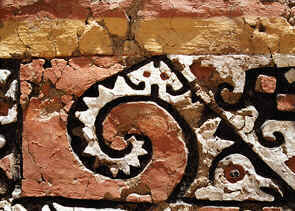
|
|
|
|
|
|
Architecture and its Function
 |
 |
| Over the
decades, the studies of Larco, Garth Bawden and Izumi
Shimada have addressed the problem of how the great Moche
monuments functioned. But their approach has been generic
and based on small excavations at very large sites. As a
result we know little about architectonic distribution
within large Moche constructions. The work of architect
Carlos Williams, largely based on reconstructions from
aerial photographs, helps us understand the general
layout and larger features of these sites. But such an
approach does not distinguish walls dating from different
phases or define architectonic spaces. In the 1970s Mackey and Hastings suggested that the Huaca de la Luna underwent three construction phases: the first is a layer of flagstones (corresponding to the floor of the patio with multicolored friezes of the fifth building); the second to the enclosure with reliefs (upper platform); and the third to the building that covered the enclosure with friezes. Recent excavations, however, do not support this line of evidence, which did not consider that the central and upper platforms were in use at the same time. Still to be discovered is the relationship among the various building stages recorded on the upper platform and the patio with reliefs and its remodelling. It is quite possible that the patio with friezes was contemporary with two of the upper platform's construction phases and that the fill covering the friezes is contemporary with the fill that covered the rooms with murals studied by Mackey and Hastings. |
|
S P O N S O R S
S P O N S O R S